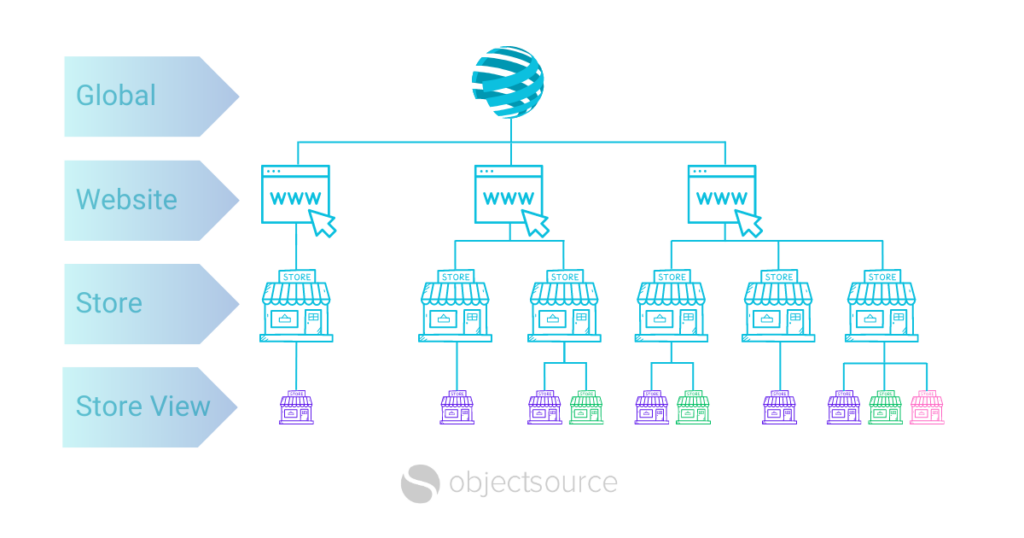
In today’s dynamic global economy, most businesses need e-commerce platforms that can seamlessly adapt to the ever-evolving demands of international markets. Adobe Commerce, formerly known as Magento, is regarded as a powerhouse in the e-commerce industry, offering a unique set of features that enable businesses to create multi-store, multi-territory, and multi-currency sites. Let’s look at the versatility and rich capabilities that set Adobe Commerce apart from other e-commerce platforms.
Contents:
- Adobe Commerce’s four-level hierarchy
- Endless possibilities with multi-store capabilities
- Navigating multi-territory challenges
- Unlocking multi-currency potential
- Powering multi-brand and microsite strategies
- Analytics and integration with third-party tools
- Conclusion
Adobe Commerce’s four-level hierarchy
Firstly, it’s useful to know Adobe Commerce has a four-level hierarchy, consisting of Global, Website, Store, and Store View.
Global: At the top of the hierarchy, the global level is like a control centre where fundamental settings are established that apply across all websites and stores. This includes stock configuration so you can manage all core product settings across the board, ensuring consistency, and price definition so you can set standardised product prices across all stores.
Website: The website level enables you to create distinct online spaces with tailored offerings. You can define different payment methods, shipping options, prices, and currencies. You can even establish separate client bases, and for each website, you can create multiple stores.
Store: Beneath the website level, the store level adds another layer of flexibility. You can create multiple stores linked to a single website, each with its own unique product line-up and category structure. Despite these distinctions, certain aspects, such as currency and pricing, payment and shipping methods, tax management, stock control, and customer accounts.
Store view: At the store view level, Adobe Commerce enables you to create different store views for each store. Store views are primarily used for different languages and currencies.

Endless possibilities with multi-store capabilities
One of the standout features of Adobe Commerce is its ability to create multi-store setups within a single platform. This means that a business can effectively manage multiple online stores under a single administrative interface. Imagine having different websites that cater to various brands, product lines, or even entirely separate businesses, all managed from one central location.
The power of this feature becomes apparent when considering the international expansion of a business. Instead of maintaining separate e-commerce platforms for different countries, Adobe Commerce allows businesses to set up individual websites tailored to specific regions, complete with localised content, pricing, and user experiences. Each website can have its own unique look and feel, making it relevant and appealing to its target audience.
Ready to revolutionise your online presence? Contact us to find out how Adobe Commerce can enable you to seamlessly manage multiple online stores and offer a uniquely personalised shopping experience.
Navigating multi-territory challenges
Operating across different territories brings about a myriad of challenges, one of which is adhering to varying tax regulations and shipping complexities. Adobe Commerce’s multi-territory capabilities shine in addressing these challenges. By designating specific sources of inventory for different territories, businesses can streamline the fulfilment process and optimise shipping costs.
Furthermore, the platform allows for granular control over taxation, ensuring compliance with the specific tax laws of each region. This is particularly crucial in the post-Brexit landscape, where cross-border tax issues have become more intricate. Adobe Commerce integrates seamlessly with third-party solutions like BlueSnap, Avalara, Vertex, TaxJar, and Digital River to simplify cross-border tax management and alleviate the burden for businesses.
Adobe Commerce’s distinction as an enterprise-grade platform is evident in the US where it can handle the intricacies of taxation across different states. Unlike other options, Adobe Commerce ensures a smooth shopping experience by accurately calculating varying tax rates. This adaptability and precision in addressing complex challenges exemplify why Adobe Commerce is a top-tier e-commerce platform for larger businesses.
Looking to conquer new territories? Contact us to discover how Adobe Commerce can help you navigate complex tax regulations, optimise shipping, and ensure compliance with ease.
Unlocking multi-currency potential
In a global market, catering to diverse currencies is essential for reaching a broader customer base. Adobe Commerce enables businesses to set up multi-currency websites, where customers can view products and make purchases in their local currencies. This feature goes beyond simple currency conversion; it allows for dynamic pricing adjustments based on factors such as region-specific shipping costs, taxes, and market demand.
A notable advantage of multi-currency setups in Adobe Commerce is the ability to personalise the entire shopping experience. Not only can businesses offer different pricing for the same product across regions, but they can also tailor content and promotions to align with local preferences, effectively engaging and converting customers on a global scale.
Powering multi-brand and microsite strategies
Adobe Commerce’s versatility extends beyond multi-store and multi-territory setups. It also empowers businesses to execute multi-brand strategies, where different brands or product lines can coexist under a single umbrella yet maintain distinct identities and websites. This is particularly valuable for companies with diverse offerings or a portfolio of brands.
Moreover, the platform is well-suited for microsite strategies, enabling businesses to create focused websites targeting specific markets or niches. For instance, during major events like a sports tournament or a seasonal sale, brands can swiftly launch microsites with tailored content and products to capture specific customer segments.
Analytics and integration with third-party tools
Adobe Commerce comes equipped with robust analytics and reporting capabilities, providing businesses with insights into their operations, customer behaviour, and sales performance. Integration with third-party tools, such as Google Analytics, further enhances data collection and analysis, allowing businesses to make informed decisions and optimise their e-commerce strategies.
Payment solutions are another critical aspect of international e-commerce, and Adobe Commerce seamlessly integrates with various payment gateways, including globally recognised options and region-specific providers. This flexibility ensures a smooth and secure payment experience for customers, regardless of their location or preferred payment method.
Conclusion
In the fast-paced and highly nuanced world of e-commerce, businesses must embrace flexibility and adaptability to succeed on a global scale. Adobe Commerce’s versatility enables businesses to transcend borders, create personalised user experiences, navigate complex tax regulations, and embrace innovative strategies. Whether a company aims to expand its presence, engage diverse audiences, or streamline operations, Adobe Commerce offers the tools to unlock a world of e-commerce possibilities.
Ready to power up your global e-commerce strategy? Embrace the limitless possibilities of Adobe Commerce’s multi-store, multi-territory, and multi-currency capabilities. Contact us to discover how Adobe Commerce can transform your e-commerce journey today.





